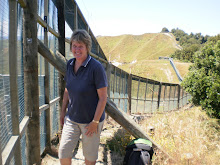
While collecting some Lizard traps in the Reserve I was lucky enough to be in the company of a very friendly North Island robin. It happily searched in the leaf litter for anything to eat and didn't mind me getting quite close for this photo.
Possibly the same robin has been seen in this spot during the late summer-we hope it has a mate out in the bush as well.
Birds I have seen often at Rotokare include fantail, woodpigeon,tui and bellbird plus various ducks and shags on the lake.

 Bushy Park is approx 30 minutes out of Wanganui.
Bushy Park is approx 30 minutes out of Wanganui.










